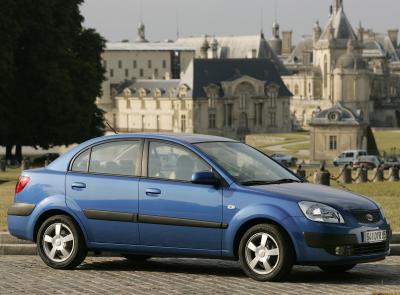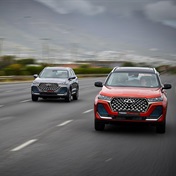
If you want to show off a car's suspension, put it onto French secondary roads.
That HAD to be the thinking behind having the world launch of the new Kia Rio four-door and 5-door cars in the Champagne region of northern France.
That and the tight winding character of the roads, the superb scenery, and, of course, the ready availability of the best bubbly in the world...
As we drove tentatively out of the parking lot of the Hyatt Hotel near the Charles de Gaul airport near Paris, it was quickly obvious Kia has invested a lot of time and effort into the new Rio, for it puts a whole new paradigm into the small/medium "B" segment.
It's styled European, it rides European, and it performs European.
Although we set out from the Hyatt, that was merely a point of convenience as journalists flew in from around the world to sample the car, and the real action took place in and around the ancient town of Chantilly.
Menacing
Our route took us mainly away from highways, a good move since the autoroutes are so busy that one learns nothing except how to avoid the megatrucks roaring along at high speed, towering menacingly above you.
Off that very beaten track the bye-roads wind through the most picturesque little towns you are ever likely to see, starting with the Chateau de Chantilly itself, a magnificent edifice built in 1528 on an island near the point where the Seine and Oise rivers meet.
It is famous for its horsey history (its builder thought he would return in his next life as a horse) and for the more important fact that the Conde Museum in the castle is second only to the Louvre in its wealth of Old Master paintings!
Unlike other estates, Chantilly was never divided, retaining its farms, ponds, forest, and magnificent horse stables decorated with statuary.
And the homes in the towns around Chantilly and even further south towards Chateau-Thierry, another ancient town where we were due to have lunch, reflect France's rich history.
Of every shape and size imaginable, from grand chateaux to tiny stone-built cottages, they are a continuing and seemingly never-ending wonder.
But I digress. You want to read about the Rio.
Market positioning
The latest Rio (code named JB) has been completely redesigned from the ground up, and offers more space, more power, higher performance, better handling, a smoother ride and enhanced fuel economy than the former Rio.
It is also higher and wider, although the hatchback is 250 mm shorter overall to bring it within class norms
Both models have a longer wheelbase (up by 90 mm) and wider track (up by 15 mm), which, says Kia, together with clever packaging of components and space, enables it to claim 'best-in-class' interior space and (on the sedan) 390 litres of luggage space - 29% larger than the previous model.
The car's wheelbase is between 9 mm and 40 mm longer than the VW Polo, Peugeot 206, Ford Fiesta and Opel Corsa, while its overall width is from 12 mm to 49 mm wider, and overall length (in five-door form) is between 30 mm and 168 mm longer than its potential hatchback rivals.
Styling
The new Rios have a very strong and youthful front end and grille, and I particularly like the wide and grinning "mouth" radiator air intake, a promise of lots of fun to come.

Another view of the Chateau Chantilly
Shaped like a flattened shield, the grille is flanked by extra-large headlamps, similar to those of its smaller sibling the Picanto, while beyond the lights wide wheel arches are flared from the bodywork.
The 5-door has a black mesh grille, while the 4-door combines mesh and slats, and both have a deep front spoiler with a wide lower intake.
From the side there's a steeply raked windscreen and quite heavy C-Pillar treatment that gives the side view a sweeping look, on the hatchback not unlike that of the hot Renault Megane RS.
From the centre pillar back the 4-door and 5-door models depart.
The hatchback has a flatish roof that culminates in a separate high-mounted spoiler and a steeply sloping rear window, while the sedan flows into a shortish boot lid.
At the rear are extra-large rear lamp clusters (parallelogram-shaped on 4-door, deltoid on 5-door) with clear lenses and surfaces.
The 5-door's tailgate features a wide rear window and a high-level brake light. Both models can be ordered with a boot-lid or tailgate spoiler. Coefficient of drag in both models is Cd 0.32.
Interior
Like the outside the interior of the car is modern and youthful, moving the car further upmarket in terms of its appeal and the quality of its fit and finish.
The dashboard is wide and sweeping, with a centrally-mounted console that features a metallic-look plastic centre panel containing the sound system and central ventilation outlets.
There's a deeply recessed instrument binnacle with brushed-chrome rimmed dials which display speed and engine revs, with inset fuel level and water temperature gauges.
The optional trip computer display shows average speed, travel distance, fuel status and distance to empty. A warning light for doors or tailgate/boot ajar is standard.
Separate steering column stalks control the two-speed and intermittent windscreen wipers and the lights. The headlamps have a manual leveling device as standard.
Interior space offers enough for four adults or two adults and a pair of teenagers. There's 1 005 mm of headroom at the front and 960 mm in the rear.
Legroom is 1 085 mm (front) and 870 mm for rear seat occupants. Shoulder room is also the same for both body styles - 1 360 mm for front seat occupants and 1 350 mm across the rear seat.
The seats are well-shaped and comfortable, and give good support in hard cornering (of which we had quite a bit) while trim materials are of good quality if somewhat plain.
Height adjustment
The driver's seat can be specified with dual-height adjustment for the front and rear of the seat cushion, with an adjustable armrest, and can be fitted with (optional) active head restraints to protect against whiplash injuries in the event of a collision.

The diesel 5-door in the little town of Betz
Manually adjustable head restraints are standard on both front seats, while the rear seat has three manually adjustable head restraints.
In hatchback models the rear seats backrests can be reclined to two positions - 26 and 31 degrees from the vertical.
In sedan models the rear seats can be fitted with a folding centre armrest and the rear seat backrest and cushion both split 60/40 and independently folded.
I found access to the cars particularly easy, this due in part to increased hip height of both front and rear seats.
There's a thick-rimmed three-spoke tilt-adjustable steering wheel.
All the cars we drove had electric windows all round, though these will not necessarily be specified on South African cars, and the driver's window has an auto-down feature for added convenience.
All cars had air-con and electrically-adjusted mirrors.
Other features include an overhead console, hinged centre fascia tray, centre console with two cupholders, door map pocket and under-dashboard tray.
There is a large glove box, pockets on the front seat backs, and bag hooks moulded into the rear of the front head restraint mountings. In sedan models there is an additional storage tray beneath the luggage floor, moulded to fit around the spare wheel.
It is expected that dual airbags will be standard in SA, although side and curtain airbags can also be specified.
Engines
There are three engines in the range, and all of them are new.
First up is a 1.4-litre petrol engine which has double overhead camshafts and multi-point fuel injection. This puts out a lusty 70.3 kW at 6 000 r/min, with 125.4 Nm of torque at 4 700 r/min.
It's a remarkable unit, and I must confess I found it smoother and almost as willing as its bigger 1.6-litre brother, which has variable valve timing.
The 1600, though obviously quick, belting out as it does 82.4 kW at 6 000 r/min and 146 Nm at 4 500 r/min, felt by comparison a bit rorty.
No prizes, though for guessing which was the pearl in this particular collection of Korean oysters - the brand spanking new 1.5-litre turbo-diesel.
Wait for it - this pumps out 80 kW at 4 000 r/min, with its 235 Nm of torque produced at a lowly 2 000 r/min.
Now, it's not so long ago that turbo-diesel 4x4 bakkies in SA were pushing out less than that from 2.8-litres!
This DOHC unit is a little beauty, with common rails, high-pressure direct injection and a variable geometry turbo-charger.
What this means in practice is that the engine is super-smooth for a small diesel, keeps up with the madding crowd with alacrity, and almost gives you the revvability you get from a petrol engine when you're hustling along narrow roads with tight corners.
The bad news is that we will probably have to wait a while before it gets here.
Suspension
At the front there are McPherson struts with gas-filled shocks and an anti-roll bar, while the rear gets a semi-independent torsion beam axle with coils and, again gas shocks.
Power steering is standard, and there are 256 mm vented discs at the front and 262 mm solid ones rear, assisted by ABS and EBS.
Wheels range from 14 inch steel with 175/70 tyres through to 16 inch alloys with 205/45 rubber, but it's not known at this stage which combinations will be available in SA.
On the road the car proves extremely able, and only in the wet did I feel uneasy at time - not because of the suspension, but because the Korean tyres didn't cope well with the greasy conditions.

The Rio 5-door outside Chateau Montvillargenne, once the home of the Rothschilds
Handling sees a modicum of understeer when you push it, but generally the cars - all three - behaved as expected.
The big plus is in ride quality.
As I intimated at the beginning, French secondary roads are not good. They are broken then repaired many times over, the edges are widened then break away, they are, in short, on average a lot worse than ours are.
Yet the Rio coped admirably. I don't remember being jarred or thrown around, I don't remember being uncomfortable - in short, it behaved as the best European small cars do, which is no mean feat.
In summary
The cars are due to come here in October, and pricing, says Kia SA MD Ray Levin, will be extremely competitive, hopefully starting just above the R120 000 mark.
Although final specifications haven't been worked out Ray says they'll be best in class, while the only bug in the woodwork is the question of supply.
Kia bosses insist they are doing their best to keep up with rapidly rising world demand, but Ray says that's not his problem - he wants as many cars as he can get, in a steady supply, so he can keep South African customers happy.
When he first told me this, before I had driven the cars, I thought he was blowing smoke.
Now, though, I can understand his concern. The Rio is one of those cars that has all the potential to become an overnight top seller.




 Publications
Publications
 Partners
Partners















